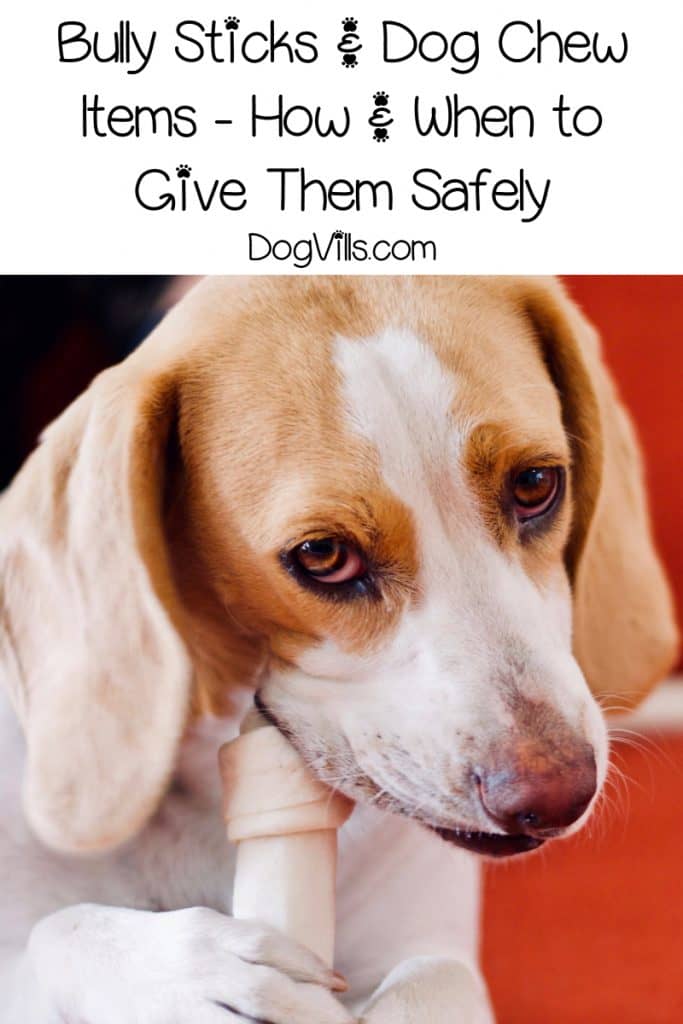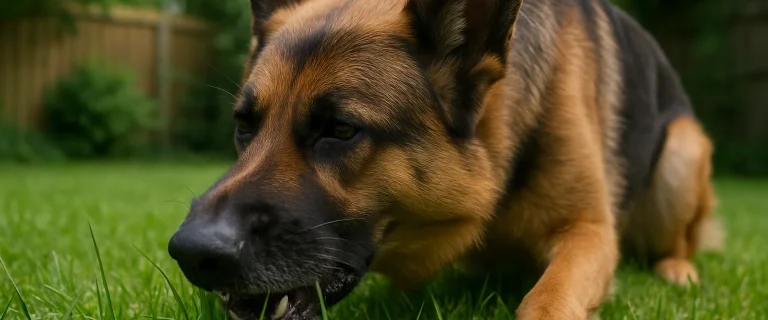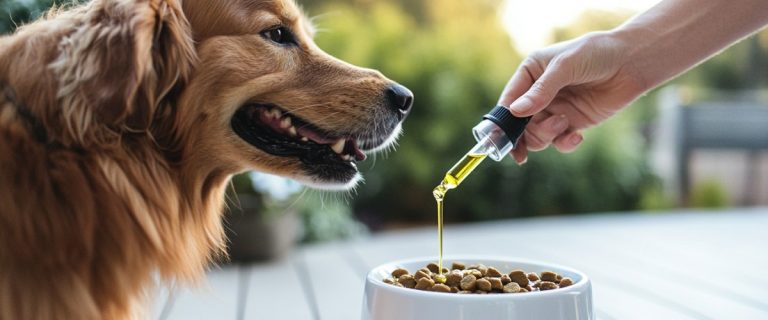Bully sticks and other dog chew items are common treats that we give our dogs.
These chews allow them to work off extra energy, relieve stress, and work out that instinct to gnaw without destroying furniture, shoes, or anything else they can fit in their mouths.
I see many questions about dog chew items from when to give them to which ones are safe.
Today, we’re going to talk about what chews are safe, what chews aren’t, and the appropriate time to start giving them to your dog.
Which Dog Chew Items are Safe

Dog chews are any kind of object designed for your dog to chew one, hence the name.
These chews come in a variety of shapes, sizes, and materials, from natural rawhide to nylon chews.
It’s important to know which of these chews are safe because not all of them are.
Unsafe Dog Chew Options
There are many popular items out there that dog owners give their dogs.
Many of them are mainstream, and they seem like safe options. That’s mainly because of their prevalence among dog owners.
However, popularity does not equal safety. Many owners find this out the hard way when their dog has to take a trip to the vet.
Here’s where it gets tricky. According to some experts, nearly every chew and bone is “unsafe.”
Other experts disagree, saying that some of the “unsafe” items are perfectly fine as long as you supervise your dog while he’s chewing them.
Rather than issuing a blanket statement about the safety of each item, we’ll take a look at both sides so you can decide.
1. Bones
Bones are one of the few chew items that nearly all experts agree are unsafe for dogs at any age.
No matter what you read on any site – and you’ll read a lot about how great bones are – do not give them to your dog. Not ever.
Many websites tout uncooked bones as a natural chew and reference wolves and their gnawing of bones as proof that these are the best thing for your dogs.
This is patently untrue. Bones are just about the most dangerous thing you can give your dog to chew on.
It’s been proven in the vet community, verified as dangerous by the FDA, and even I, a knowledgeable dog owner, had to learn this the hard way.
Wolves may eat bones, but it’s not because they’re good for their teeth. They eat them to help balance calcium levels in their bodies.
Domestic dogs don’t need this. In addition, bones are far too hard for a dog’s teeth. We learned this the hard way when we gave our dog a knuckle bone.
He was such an aggressive chewer that in one chewing session, he cracked three teeth.
Lastly, bones splinter, which can lead to puncture injury of the mouth, or far worse, the GI tract.
What the other side says:
A few scattered holistic vets and proponents of raw diets do say that bones are fine as long as they’re raw.
Even then it’s with plenty of warnings and caveats, so you really have ask yourself, is it worth it?
PS- if you’re thinking, “I know I’ve seen dog bone recommendations on this site,” you’ll note that we use the loosest definition of the word and recommend alternatives to cooked animal bones.
2. Hard Cheese Blocks and Bones
Yes, these are hard as a rock (which isn’t really good for your dog’s teeth) but what’s even worse is their size.
Most of these blocks are small enough that your dog can swallow them whole.
Being too small and rock hard is the perfect combination for an obstruction, which occur when a foreign body becomes lodged in the intestinal tract.
At best, this requires constant vigilance to see if your dog passes that object. At worst, it can lead to death without drastic measures such as surgery.
What the other side says:
While some vets will tell you to stay far away from hard cheese chews, others say they’re perfectly safe for your dog and a great alternative to bones.
If you do decide to give hard cheese treats, opt for the larger treats versus blocks, and supervise your dog with them.
When it gets too small, either throw it away or microwave the nub to turn it into a soft treat.
3. Cow Hooves
Cow hooves pose a double threat when used as dog chews.
They are too hard for the teeth and they can splinter, leading to injury of the mouth or digestive tract.
You’ll find very few experts who disagree with that, so there’s really no “other side” to this one.
A few random trainers will say they’re fine for moderate chewers as long as you buy US-sourced hooves.
4. Antlers
Elk and deer antlers have been touted as a natural, sustainable dog chew option that every dog loves.
They are absolutely terrible for your dog.
Antlers are designed to be strong enough to sustain the impact of two large animals barreling at each other and repeatedly smashing those antlers together.
Obviously, this makes them far too hard for your dog’s teeth. In addition, the points of the antlers can and have caused injuries to dogs who chew aggressively.
In fact, these antlers have caused so many injuries that many vets and board-certified veterinary dentists have issued warnings for owners to avoid them.
The other side:
The AKC comes down pretty strongly on the side of “antlers are unsafe,” however they do point out that not all dogs will have a problem with them.
If you do decide to risk it, please make sure you supervise your dog’s chewing the entire time they have an antler.
5. Nylabones and Other Nylon Chew Toys
One of the most popular dog chew items on the market today is Nylabones or nylon chew toys.
These are tricky. They appear to be safe. After all, they don’t splinter, right? Well, not really.
Nylon toys may not splinter, however, a particularly aggressive chewer can rip pieces off of them, which could lead to obstruction.
In addition, these bones have little to no give, which makes them dangerous for a dog’s teeth, as well.
The other side:
Most of the warnings issued about Nylabone have to do with their Plaque Attackers, which are too hard for anything but the most aggressive chewer.
CanineJournal explains that nylon bones can be safe as long as you choose the right size and supervise your dog with them.
If your dog manages to break off pieces of the chew, throw them away so they don’t become a choking hazard.
6. Pig Ears
Pig ears don’t splinter, which is good. However, the coating used on them can make some dogs sick, which is bad.
In addition, aggressive chewers can tear off large chunks of these, which, when swallowed, can lead to obstruction.
Given the current recall on pigs ears due to salmonella, it’s best to completely avoid them for now, so we’re going to skip “the other side,” because we don’t want to encourage anyone to risk it.
7. Sticks
Finally, we come to the most classic of all dog chews – the humble stick.
Sticks have a popular place in our culture as the wholesome dog chew and play item of yesteryear.
Whenever anyone thinks of fetch or chewing, they most commonly think of sticks first.
However, sticks are terrible for dogs.
They splinter more easily than bones, they splinter more often, and they can and do lead to puncture wounds of the mouth, throat, and GI tract.
In addition, they can cause obstruction.
There is no “other side” to this one, as pretty much every expert agrees that sticks should NOT be used as chew toys.
You can still play fetch with them, just take them away before your dog can start chewing them.
Safe Dog Chew Options

Now that we’ve covered all the dog chew options out there that are just terrible for your dog, let’s talk about the winners.
These dog chews offer a great chewing experience without any danger. With these, your dog can chew away, and you won’t have to worry about vet trips or other injury.
Unfortunately, the list of safe dog chews is far shorter than the list of unsafe ones. On the other hand, the few that are safe are beloved by dogs!
Kong and Other Feeder Chews

The Kong company makes a variety of rubber chew toys and interactive feeders for dogs.
These toys are non-toxic and designed to stand up to even the most rigorous chewer without being too hard on their teeth.
What makes these great is that you can stuff treats into the center to encourage your dog’s chewing.
This gives your pooch a treat and their teeth a nice workout.
Bully Sticks

Bully sticks are big winners on the dog chew front, in my opinion.
Unlike bones, they don’t splinter, and unlike rawhides, they are highly digestible.
That means that if your dog rips off a big piece, you won’t be going to the vet for an x-ray.
Bully sticks are made from dried beef muscle. That’s it. One ingredient.
They are hard enough to offer great chewing benefits but soft enough not to damage teeth.
In addition, they are a complete source of amino acids, so they’re also benefiting your dog’s muscles, brain, skin, and coat in addition to their teeth and gums.
To make the chewing experience last longer for both regular chewers and hardcore chewers alike, I recommend a braided bully stick.
A braided bully stick is essentially three bully sticks braided into one. This braided design does two important things.
It makes the stick last longer, and those extra bumps from the braiding help remove even more plaque from a dog’s teeth.
For a teething dog, this braided texture feels amazing on their sore gums.
When to Give These Two Dog Chew Options
In general, you should begin giving your puppy these dog chew options when he begins teething.
Teething is a painful process and chewing helps alleviate that pain by helping the teeth break through the gums.
It causes an intense desire to chew, which is why many puppies become so destructive.
They need to chew so badly that they will gnaw on absolutely anything. That means your best course of action is to get that chew into their mouths immediately.
For teething puppies, I recommend the bully stick.
Kong and other feeder toys are more appropriate for older dogs as a form of entertainment and stimulation.
However, puppies have one job in mind: relieving the pain of teething.
Braided bully sticks are the perfect dog chew option because the texture and shape allow your puppy to really work his gums from the front all the way to the back of his mouth.
Stick with My Two Recommended Dog Chews
No matter what any website or other dog owner tells you, stick with Kongs and bully sticks for dog chew options.
There is too much potential for injury with pretty much any other dog chew out there.
While you may hear stories from other owners about how their dogs have been chewing on X dog chew for years with no problem, that doesn’t mean that a problem can’t happen.
Remember, an ounce of prevention is worth thousands of dollars in cure when it comes to our dogs.
What are your thoughts on the safety of dog chew items? Share below!
Author
-

A former Veterinary Assistant at Southwest Animal Care Hospital, Ben is an animal lover, blogger, and all-around geek. Along with writing for DogVills, Ben runs his own virtual assistant company, BizzyBim.
View all posts

![Dog [Bone] Pile](https://live.staticflickr.com/4640/38523983785_61a8e80688_c.jpg)




